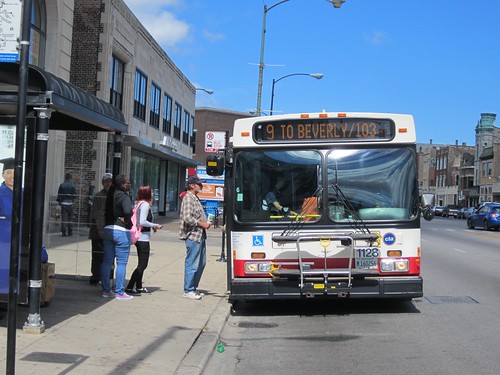In recent months the anti-bus rapid transit group the Ashland-Western Coalition, led by Roger Romanelli, has garnered plenty of ink in the mainstream press for their opposition to the CTA’s plan to create fast, reliable transit on Ashland Avenue. Meanwhile, the Active Transportation Alliance’s Bus Rapid Transit Action Team has been quietly spreading the good word about the benefits of the plan to residents and merchants along the corridor.
“Since August we’ve been working with about a dozen volunteers to do outreach to bus riders and businesses,” said Brenna Conway, who manages Active Trans’ Riders for Better Transit campaign. “We’ve been giving people handouts with information about BRT and explaining how it will lead to shorter commute times and better conditions for walking. If they’re interested, we ask them to sign our petition supporting the plan. Many of the people we’ve talked to are very excited about BRT.”
The action team has done four outreach events so far along the stretch of Ashland between 31st Street and Cortland Street where Phase I of the project will be built. The team spent two days talking to people waiting for the bus by the Ashland/Lake 'L’ station, a busy bus-and-train transfer point, and another two days visiting businesses on and near Ashland between Ogden Avenue and Division Street. The First Ward Transportation Advisory Committee, which has endorsed BRT, has also been helping out, speaking with businesses in the ward on and near Ashland north of Division.
The outreach workers have been asking the CTA customers about their bus riding experiences, and whether they find the current service to be convenient and dependable, Conway said. “We’ve been telling them that we think BRT will improve speed and reliability and make it easier to connect with other transit lines,” she said.
Most of the business owners and employees they’ve talked to along Ashland were unfamiliar with the plan. “But they’re open to the idea and interested in the benefits for their customers and employees,” Conway said. “These are our first steps in doing direct outreach along the corridor. We want to make sure businesses have all the info, and hopefully they’ll be interested in voicing their support.” She said they’ve gotten positive responses from many shops and restaurants along the street.
What do they say to residents and merchants who are incredulous about the plans to convert two of the four travel lanes on Ashland to bus-only lanes and prohibit most left turns? “We tell them that that over 30,000 people a day are currently riding the Ashland bus, and those numbers will rise significantly once we improve speed and reliability, so that will help get cars off the road,” she said. “We also point out that this isn’t the first time BRT has been implemented. It’s been done successfully in many other cities without creating the doomsday scenarios we know people are concerned about.”
The CTA is planning to hold a series of public meetings on the BRT plan, although these have been delayed, since the government shutdown slowed the federal approval process for the project’s environmental assessment document. “We hope to get a big turnout from supporters at these meetings, so we’ve been collecting contact info from the people who we talk to who are interested, so that we can remind them to show up,” Conway said.
In the near future, Active Trans plans to set up a curbside pop-up exhibit about the elements of BRT and the benefits it brings, at various locations along the corridor, hopefully before the end of the month. To get involved with the BRT Action Team, fill out a contact form here, or email campaigns[at]activetrans.org for more info.








